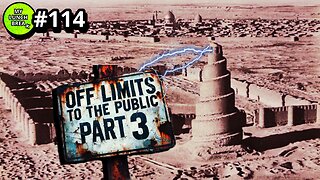Premium Only Content

Episode 2594: Seventh Sword of Sorrow - with Sharon
The Seventh Sword of Sorrow: Mary Helps Place the Body of Jesus in the Tomb
Sharon:
Welcome back to CR. I’m Sharon, your host, and as always, I'm joined by my wonderful co-host, Walt. How are you doing today, Walt?
Walt:
I’m doing well, Sharon. Today’s reflection is both sorrowful and filled with hope. We’ll be discussing the Seventh Sword of Sorrow, where Mary helps place the body of Jesus in the tomb a moment that deeply speaks to us about faith in the darkest hours. Do you mind opening with a prayer?
Opening Prayer:
Sharon:
"In the name of the Father, and of the Son, and of the Holy Spirit. Amen.
Heavenly Father, as we gather to reflect on the final sorrow of Our Blessed Mother, we ask for the grace to meditate on the profound faith and hope she carried even as she helped lay the body of her Son in the tomb. Give us the grace to hold onto the same unshakable trust in Your promises during our own dark moments. May this reflection bring us closer to the mystery of the Cross and the Resurrection. Through Christ our Lord. Amen.
Sharon:
The Seventh Sword of Sorrow is perhaps one of the most poignant images in the devotion to Our Lady of Sorrows. After witnessing the brutal death of her Son on the cross, Mary participates in His burial. The Gospels tell us that Joseph of Arimathea and Nicodemus took the body of Jesus, and Mary was there, helping to wrap His broken body in the burial cloths. The child she once swaddled in Bethlehem now lies cold and lifeless in her arms." From The Glories of Mary I’d like to read a few passages if you don’t mind just to set the stage.
WHEN a mother is by the side of a suffering and dying child, she no doubt then feels and suffers all his pains; but when the afflicted child is really dead and about to be buried, and the sorrowful mother takes her last leave of him, oh God ! the thought that she is to see him no more is a sorrow that exceeds all other sorrows. Behold, the last sword of sorrow which we are to consider, when Mary, after being present at the death of her Son upon the cross, after having embraced his lifeless body, was finally to leave him in the sepulchre, never more to enjoy his beloved presence.
But that we may better understand this last dolor, let us return to Calvary, again to look upon the afflicted mother, who still holds, clasped in her arms, the lifeless body of her Son. Oh my Son, she seems then to continue to say in the words of Job, my Son, thou art changed to be cruel towards me. Yes, for all thy beauty, grace, virtue, and loveliness, all the signs of special love thou hast shown me, the peculiar favors thou hast bestowed on me, are all changed into so many darts of sorrow, which the more they have inflamed my love for thee, so much the more cause me cruelly to feel the pain of having lost thee. Ah, my beloved Son, in losing thee I have lost all. Thus St. Bernard speaks in her name: Oh truly begotten of God, thou wast to me a father, a son, a spouse; thou wast my life! Now I am deprived of my father, my spouse, and my Son, for with my Son whom I have lost, I lose all things.
Thus Mary, clinging to her Son, was dissolved in grief; but those holy disciples, fearing lest this poor mother would expire there through agony, went to take the body of her Son from her arms, to bear it away for burial. Therefore, with reverential force they took him from her arms, and having embalmed him, wrapped him in a linen cloth already prepared, upon which our Lord wished to leave to the world his image impressed, as may be seen at the present day in Turin. And now they bear him to the sepulchre. The sorrowful funeral train sets forth; the disciples place him on their shoulders; hosts of angels from heaven accompany him; those holy women follow him; and the afflicted mother follows in their company her Son to the grave. When they had reached the appointed place, how gladly would Mary have buried herself there alive with her Son! “Oh how willingly,” said the Virgin to St. Bridget, “would I have remained there alive with my Son, if it had been his will!” St. Fulgentius says, the Virgin earnestly desired that her soul should be buried with the body of Christ. And Mary herself made this revelation to St.Bridget also: “I can truly say, that at the burial of my Son, one sepulchre contained as it were two hearts.”
Finally, they take the stone and close up in the holy sepulchre the body of Jesus, that great treasure, greater than any in heaven and on earth. And here let us remark, that Mary left her heart buried with Jesus, because Jesus was all her treasure. As it states in Matthew 6:21,“Where your treasure is, there will your heart be also.” And where shall we keep our hearts buried ? With creatures ? In the mire ? And why not with Jesus, who, although he has ascended to heaven, has wished to remain, not dead but alive, in the most holy sacrament of the altar, precisely in order that he may have with him and possess our hearts ? But let us return to Mary. Before quitting the sepulchre, according to St. Bonaventure, she blessed that sacred stone, saying: Oh happy stone, that doth now inclose that body which was contained nine months in my womb, I bless thee, and envy thee; I leave thee to guard my Son for me, who is my only good, my only love. And then turning to the eternal Father, she said: Oh Father, to thee I recommend him, who is thy Son and mine; and thus bidding a last farewell to her Son, and to the sepulchre, she returned to her own house. This poor mother went away so afflicted and sad, according to St. Bernard, that she moved many to tears even against their will: so that wherever she passed, all wept who met her: and could not restrain their tears. And he adds, that those holy disciples, and the women who accompanied her, mourned for her even more than for their Lord.
St. Bonaventure says that her two sisters covered her with a mourning cloak: The sisters of our Lady wrapped her in a veil as a widow, covering as it were her whole countenance. And he also says, that passing, on her return, before the cross, still wet with the blood of her Jesus, she was the first to adore it : Oh holy cross, she exclaimed, I kiss thee and adore thee; for thou art no longer an infamous wood, but a throne of love, and an altar of mercy, consecrated by the blood of the divine Lamb, who has been sacrificed upon thee, for the salvation of the world. She then leaves the cross and returns to her house ; there the afflicted mother casts her eyes around, and no longer sees her Jesus ; but instead of the presence of her dear Son, all the memorials of his holy life and cruel death are before her. There she is reminded of the embraces she gave her Son in the stable of Bethlehem, of the conversations held with him for so many years in the shop of Nazareth: she is reminded of their mutual affection, of his loving looks, of the words of eternal life that came forth from that divine mouth. And then comes before her the fatal scene of that very day ; she sees those nails, those thorns, that lacerated flesh of her Son, those deep wounds, those uncovered bones, that open mouth, those closed eyes. Alas! what a night of sorrow was that night for Mary! The sorrowful mother turned to St. John, and said mournfully: Ah, John, where is thy master? Then she asked of Magdalene: Daughter, tell me where is thy beloved ? Oh God ! who has taken him from us ? Mary weeps, and all those who are with her weep. And thou, oh my soul, dost thou not weep! Ah, turn to Mary, and say to her with St. Bonaventure : Let me, oh my Lady, let me weep ; thou art innocent, I am guilty. At least entreat her to permit thee to weep with her: he weeps for love, and thou dost weep through sorrow for thy sins.
The passages from The Glories of Mary beautifully capture the profound sorrow of the Blessed Virgin Mary as she experiences the death and burial of her Son. Here are some follow-up points and questions that might enrich the discussion or reflection on this text:
Follow-Up Points
1. The Depth of Maternal Grief: parent-child relationship.
2. Mary as a Model of Suffering: model for enduring suffering and loss, embodying patience and strength even amidst overwhelming sorrow.
3. Symbolism of the Sepulchre: The sepulchre is not just a physical space but a symbol of hope, transformation, and the promise of resurrection.
4. The Role of Disciples: Consider the actions of the disciples and holy women in supporting Mary.
5. Mary's Embrace of the Cross: Analyze Mary's reaction to the cross and her expression of love towards it.
6. Remembrance of Christ’s Life: Reflect on how Mary’s memories of her Son shape her grief. This could lead to discussions on how memories of loved ones impact our own grieving processes.
7. The Spiritual Dimension of Grief: Discuss the spiritual implications of Mary's grief, particularly her relationship with God and how she models a deep faith in the face of suffering.
8. Invitation to Weep: The text invites readers to join Mary in her sorrow, prompting reflection on personal sinfulness and the call to compassion.
Walt:
It’s hard to imagine the depths of Mary’s sorrow in this moment. This is the same Jesus whom she cared for as a child, the Son of God who brought light and life to the world. Now, her tears mingle with His blood and the dirt of Golgotha. And yet, as the reflection states, even in the midst of this immense sorrow, Mary’s hope in God’s promise did not die.
Sharon:
Exactly, Walt. Despite the agony, Mary never lost faith. She knew that this was not the end. But, lets remember, she was a human. She suffered as we would suffer as humans. Her suffering was more because of her deep spiritual nature which many of us will never achieve. Pain is pain, sorrow is sorrow as we know it. However, her mourning was filled with hope, a hope rooted in her belief that Jesus would rise from the dead. In a world that often sees death as the final word, Mary’s hope teaches us something deeply countercultural: that life and light follow the darkness of suffering and death. And, we must remember, that we too should have hope of seeing our dearly departed in Heaven one day. That is why it is so important to be a good witness and lead others especially those we love to Christ.
Walt:
Right. And from a traditional Catholic perspective, Mary’s role in this moment is a perfect example of trusting in God's providence. In the burial of Jesus, she showed a faith that endured even when everything seemed lost. Her unshakable hope is something we can all look to when we face our own trials. How often do we struggle to believe in the victory of God when things seem dark? But Mary teaches us that true hope does not waver, even when faced with the tomb.
Sharon:
And what’s incredible is how Mary’s suffering was not just personal, but redemptive. As Catholics, we understand that suffering, when united with Christ, can have immense value. Mary, as Co-Redemptrix, participated in Christ’s suffering and redemption in a way that no one else could. Her faith and suffering at the tomb were not in vain they were part of the unfolding of God’s salvific plan.
Walt:
Yes, Sharon. And this is a reminder that we, too, are called to trust in God’s promises, even in our darkest moments. We may not understand why certain sufferings are allowed in our lives, but like Mary, we can trust that God is always at work, even in the face of death. Her example gives us the courage to hold on to hope when we feel overwhelmed by sorrow.
Sharon:
Absolutely. The Seventh Sword of Sorrow is not just about Mary’s pain, but also her unwavering hope in the Resurrection. She believed that Jesus would rise, even when all seemed lost. In our own lives, we face many moments of trial, where it feels like we are standing at the tomb, burying our hopes and dreams. But we are called, like Mary, to believe that the story doesn’t end in the grave.
Walt:
That’s such an important point, Sharon. Even in moments of profound grief, we are never without hope. Mary trusted that Christ’s suffering and death were not the end but a pathway to eternal life. In our own moments of loss or despair, we must remember that there is always resurrection on the horizon, even if we cannot see it yet.
Sharon:
Yes, and through this reflection, we ask for the grace to imitate Mary’s faith. As the prayer for this sorrow says: 'O Mother of Sorrows, your mourning was not without hope, for you knew that He would rise again from this grave just as He promised. Through this bitter sword of sorrow obtain for us the grace to believe with unshakable hope in the victory of our Lord even in the darkest moments of life. And, let us not forget that according to a mystic whom I can’t remember if it was Katherine Emmerich or Mary of Agreda said that for the rest of Mary’s life, she would set up stations of the Cross everywhere she stayed and spent her day meditating and reflecting on them.
Walt:
And what a grace that would be. To trust so deeply in God’s promises, even in the midst of suffering, would give us peace in knowing that everything is in His hands. Mary’s example is a guide for us all.
Sharon:
Yes, her unwavering faith in God’s plan is something we should strive for in our lives. Before we close, let’s remember to pray to Our Lady of Sorrows, asking her to obtain for us the grace of deep and abiding hope, especially when we face our own personal tombs of loss, disappointment, or grief.
Closing Prayer
Walt:
In the name of the Father, and of the Son, and of the Holy Spirit. Amen.
O Mother of Sorrows, you who helped to place the body of your Son in the tomb with deep sorrow but also unshakable hope, intercede for us that we may always trust in the promise of the Resurrection. Obtain for us the grace to remain steadfast in faith, even when we face the darkest moments of our lives. May we always hold onto hope, believing in the victory of Jesus over death and sin. We ask this through Christ our Lord. Amen.
In the name of the Father, and of the Son, and of the Holy Spirit. Amen.
Sharon:
Thank you for joining us for today’s reflection on the Seventh Sword of Sorrow. Remember, in your own sufferings, to turn to Our Blessed Mother and ask for her intercession, for she knows the way through grief and leads us to the joy of the Resurrection.
Walt:
Until next time, may God bless you, and may Our Lady of Sorrows guide you through every trial with hope and faith in God’s promises.
-
 34:27
34:27
The Connect: With Johnny Mitchell
12 hours ago $5.73 earnedCan He Stop Them? Inside Trumps War On Mexican Drug Cartels & The New Era Of Mexican Organized Crime
13.5K2 -
 2:33:15
2:33:15
Tundra Tactical
4 hours ago $4.68 earnedLuis Valdes Of GOA Joins The Worlds Okayest Firearms Live Stream!!!
14.9K -
 1:03:41
1:03:41
Man in America
13 hours agoAre Trump & Musk the COUNTER-ELITES? w/ Derrick Broze
43.6K27 -

DLDAfterDark
4 hours ago $5.67 earnedDLD Live! SHTF Handguns! Which Would You Choose?
24.4K1 -
 1:50:38
1:50:38
Mally_Mouse
6 hours agoSaturday Shenanigans!! - Let's Play: Mario Party Jamboree
36.2K -
 1:13:00
1:13:00
Patriots With Grit
10 hours agoWill Americans Rise Up? | Jeff Calhoun
29.1K10 -
 14:55
14:55
Exploring With Nug
10 hours ago $9.92 earnedWe Found Semi Truck Containers While Searching for Missing Man!
47.6K7 -
 27:57
27:57
MYLUNCHBREAK CHANNEL PAGE
18 hours agoOff Limits to the Public - Pt 3
98K62 -
 38:07
38:07
Michael Franzese
11 hours agoLeaving Organized Crime and Uncovering Mob in Politics: Tudor Dixon and Michael Franzese
85.5K15 -
 2:42:54
2:42:54
Jewels Jones Live ®
2 days agoAMERICA IS BACK | A Political Rendezvous - Ep. 111
69K46